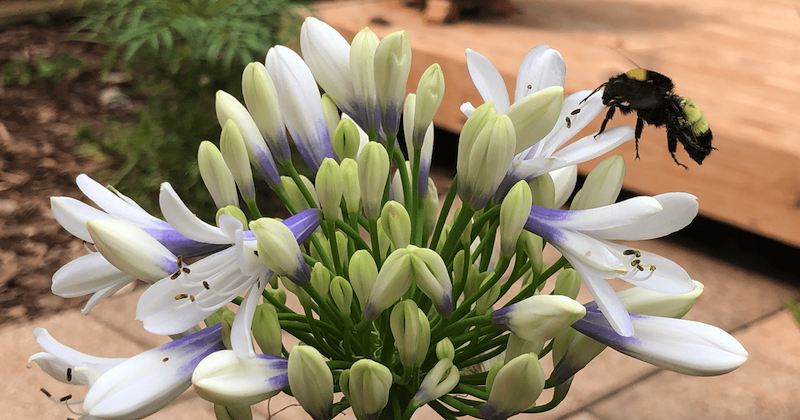Agapanthus sends up a spectacular burst of flowers in July, which continues for 6 – 8 weeks. For this floral display to happen, these plants require specific growing conditions. They appreciate plenty of sunshine, good drainage, regular watering, and light fertilizing. They also need time to settle in after planting, so be patient for the first couple growing seasons as they establish a good root system. Stress from pests, hard freezes, drought, and transplant can all contribute to lack of blooming.

Common Reasons Why Agapanthus Aren’t Blooming
Agapanthus hails from southern Africa where it grows in areas with heavy summer rainfall. In the garden, it will require at least 6 hours of direct sunlight a day. If it is planted in too much shade, agapanthus will become weak and leggy, blooming little to not at all.
This plant also requires regular water during the growing season. Exposure to long periods of drought can prevent the formation of buds for next summer’s flowers. Agapanthus do not tolerate wet feet and are especially susceptible to rot during cold, wet winters. To prevent rot and limit fungal disease, plant this perennial in well-draining soil.
Agapanthus take time to establish their roots and flower best when their roots are somewhat crowded. Only divide these plants when necessary, as freshly divided plants may not flower the first year after transplant.
Pruning Agapanthus To Help It Bloom
Agapanthus does not need to be pruned to bloom better. Deadheading can divert energy away from seed production, which will help the plant conserve energy, but it will not increase the flower yield. Watch out for snails and slugs, which can “prune” the plant for you and cause damage. Damage from pests can reduce the health of the plant and prevent your plant from flowering.
Fertilizing Agapanthus To Help It Bloom
Agapanthuses are heavy feeders and will bloom better with regular feeding. In the spring, apply a water-soluble fertilizer, rich in potash, twice a week. Cut back to once a month when flowering starts, and stop fertilizing at the end of the bloom period. Potash is important because it helps support the development of flower buds. Avoid formulas high in nitrogen, which promotes foliage production at the expense of flowering.
Get Agapanthus To Produce More Blooms
To help your agapanthus put on its best show, make sure it is receiving plenty of sun. If it is being shaded by other plants or buildings, consider moving it to a sunnier location. During the summer, make sure your agapanthus receives a good soaking whenever the soil feels dry. Feed regularly with a light application of potash-rich fertilizer from the spring to fall. Check for damage from fungus and pests, and treat any diseases present, such as anthracnose or gray mold.

Why Agapanthus Isn’t Blooming
- Plants require 6 hours of sunlight per day
- Provide regular water in the summer
- Feed with potash-rich, soluble fertilizer in the spring
- Susceptible to rot in boggy soil
- Transplants need time to settle in
 |
Author Jessica Mercer - Published 6-28-2022 |
